Addendum to this article added Jan. 15 2022 by Winslow Myers, author of the new book on Walter Murch,
In Larry’s compendium of Murchiana below, he is kind enough to mention an essay on Murch I wrote some years back that I had put on my own painting website, www.winslowmyers.com. (I was briefly a student of Murch’s at Boston University back in the 1960s. ) You won’t find the essay on my site now because it became part of a long and complex effort, very much needed, to put out a large, comprehensive book on Murch and his work.
The filmmaker George Lucas owns an extensive Murch collection and was able to support the publication by Rizzoli in September of 2021 of a 324-page oversize monograph, “Walter Tandy Murch: Paintings and Drawings: 1925-1967,” every plate in full color. Even Murch’s commercial work, such as his dozen covers for Scientific American, repays close study, so the book contains a generous selection of his commissions.
Lucas was kind enough to write a Foreword, and there are essays by the artist’s son Walter Scott Murch, the famous film editor; Judy Collischan, the foremost Murch scholar; the curator, critic and author Robert Storr; and me. Better late than never that this great artist has, at last, received the kind of comprehensive treatment he deserves.
There are a number of other interesting catalogs about Murch, some of which Larry and commenters mention below, which contain essays worth reading, even if they are hard to obtain. For example, the catalog for Murch’s retrospective in 1966, black and white reproductions only, but with an excellent biographical essay by Daniel Robbins, has been selling on Amazon for 800 dollars a copy. You can enjoy our big new book for a thirteenth of that.
We introduce the book in a celebratory webinar which can be seen here or from the link to youTube – https://www.youtube.com/watch?v=rWZoxhBNnO0
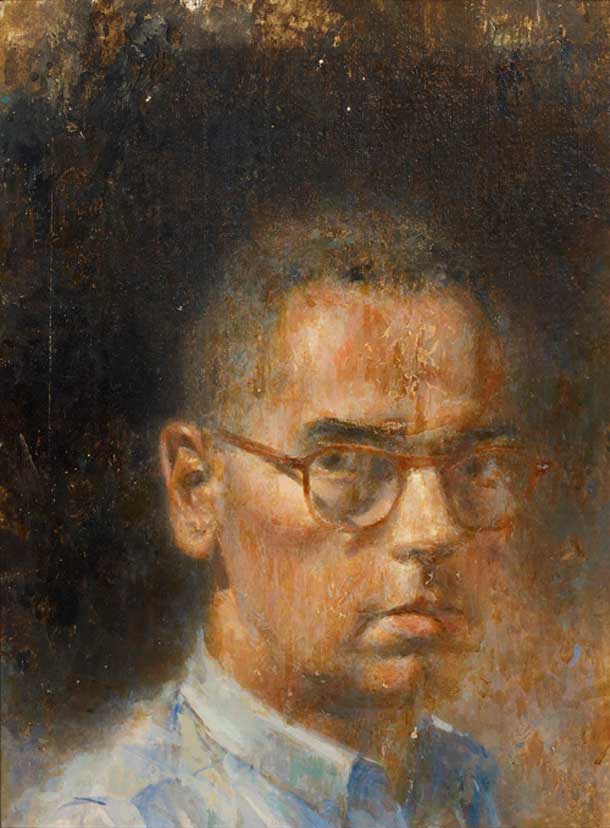
Self Portrait with Glasses, c. 1960
What does the mind wander to the most while just painting. For me, the secret seems to be paint the Best (controlled) way you can and to your utmost. But while painting let the mind go way out in space. Let the mind wish or desire for the things you know should be (but are not). Let the mind correct what is wrong. Usually the subject you happen to be working on determines to a great extent the path the mind takes. A whole new world exists and moves in the mind while actually making a painting . . . But the thing to remember is that the world that the mind returns to the most will come out, will show in the completed picture . . .
—Walter Murch
(Murch, journal note, circa 1951, from Archives of American Art, “Murch Papers,” microfilm N68-5, frame 330, quoted p.153 in Judy Collischan,”Walter Murch,” Doctoral Thesis, University of Iowa, 1973) from Winslow Myers essay “The Recreated Image: Walter Murch at Sixty”
Walter Tandy Murch, (1907–1967) was an important still life painter who until recently it has been very difficult to find information or see many images of his work online but recently I read a terrific essay on his painting: The Recreated Image, Walter Tandy Murch at Sixty, by Winslow Myers This essay has many quotes from Murch and many fascinating biographical details about Walter Murch’s art and life. One important theme in this essay is the relation to Murch with abstract expressionism.
This Pollock-like interest in paint for its own sake and the transformation of ordinary objects into painted forms suggest that Murch’s closest artistic kinsmen may have been Giorgio Morandi or Balthus, both of whom he admired. The task for all three of these artists was to subsume the subjects used into the painting itself, so that we would not for a moment see them in their former utility, but as abstract fragments that interact to give a work its life. But Murch, at least in his mature work, differed from Balthus and Morandi in his willingness to make use of the accident, to throw paint at the surface in an easel-size equivalent of what Pollock did on a larger scale. The “rightness” of such random marks was a function of the experience of many accidents and many decisions about whether to accept or reject them on the basis of whether they made the work seem more alive. Murch would sometimes jokingly remind students to take care that their palettes were not more interesting than their paintings.
For the sake of this potential interest he would leave the future surfaces of drawings and paintings on the floor of his studio or under his easel, where dirt or random paint splatters could eventuate in something he could continue. This radical openness to anything that might give his work more life allowed him not only to incorporate accidents of thrown paint, but to include or even develop half-hidden images that seemed to well up from his unconscious.
from The Recreated Image, Walter Tandy Murch at Sixty, by Winslow Myers
There aren’t many good online sources of images of his work and the images you do find tend to be on the small side. Tim Lowry’s links site has a very nice selection of images of his work that is worth checking out.
Recently a terrific new book on Walter Tandy Murch was published: Walter Tandy Murch: The Spirit of Things
Bill Jeffries & Ihor Holubizky
Two thoroughly researched essays lay out the scope of Murch’s diverse and original career. The publication’s dustjacket opens into a large illustration. In English and French with 98 pages and 50 color illustrations. $26.95 U.S. No direct link to the book so you need to click on “artists” and then find Murch alphabetically. Here is the link to the Art Books Canada site.
I recently scanned my catalog of the 1966 catalog for Walter Murch, A Retrospective Exhibition by the Museum of Art, Rhode Island School of Design. The catalog was printed in black and white. This catalog is long out of print and most likely impossible for most people to obtain. In addition to posting many images from this book I’m also linking to the OCR conversion of the scanned essay by Daniel Robbins – another terrific essay, richly detailed with biographical information and scholarly insight. The late Daniel Robbins was an art historian at the The Rhode Island School of Design who organized Murch’s first major retrospective in 1966, a year before his death from a heart attack on December 11, 1967.
I have no permission or copyright to any of the images or text and it is my wish to make this available to readers as a fair-use for educational purposes, free to any painter and art lover who wishes to find out more about this important but often neglected American artist. I’ve also included a few color images of his paintings that I’ve been able to find that can give you an idea of what his color was like. His work is often more tonal in nature so the black and white images read well, especial with the higher resolution images.
Link to the PDF of the Essay by Daniel Robbins for the Walter Murch Retrospective
from the Wikipedia page on Walter Murch
…Walter Tandy Murch (August 17, 1907 – December 11, 1967) was born and grew up in Toronto, Canada and studied under Arthur Lismer, a member of the “Group of Seven” Murch moved to New York in 1927 and studied at the Art Students League of New York under Kenneth Hayes Miller and later, with Arshile Gorky at the Grand Central School of Art.
In 1929 he married Katharine Scott, and from then until 1950 Murch supported himself and his family through a number of jobs on the fringes of the art world including department-store window design, book illustration, restaurant murals, freelance illustrations (notably covers for the magazines Fortune and Scientific American) and advertising commissions while he continued painting and studying contemporary art. In 1941 Betty Parsons presented Murch’s first one-man exhibition at the Wakefield Gallery in New York City. When Parsons established her own gallery in the mid 1940s, Murch moved with her, mounting one-man shows every two years until his death in 1967. After 1950, he also began teaching at Pratt Institute and later at New York University, Columbia University and Boston University. Daniel Robbins at The Rhode Island School of Design organized Murch’s first major retrospective in 1966, a year before his death from a heart attack on December 11, 1967.
Murch’s style remains difficult to classify, although he has been variously described as a Magic Realist, Surrealist, Romantic Realist or just plain Realist. For subjects, he favored motors, tools and scientific equipment which would often be incongruously arranged with more traditional still life elements such as fruit, bread and fragments of rock. These mysterious and eccentric juxtapositions seem to imply poetic associations although Murch himself tended to dismiss this sort of interpretation of his work, saying of the objects he chose to paint that they were simply an excuse to paint…
… In 2009 and 2010, Ihor Holubizky and Bill Jeffries curated a traveling exhibit entitled: Walter Tandy Murch: The Spirit of Things. This exhibit was circulated by the Robert McLaughlin Gallery and partially funded by the Government of Canada through the Department of Canadian Heritage, Museums Assistance Program. The exhibit was displayed in the The Robert McLaughlin Gallery in Toronto (Ontario) 4 July to 30 August 2009, the Confederation Centre Art Gallery in Charlottetown (Prince Edward Island) January 2010, Owens Art Gallery in Sackville (New Brunswick) 26 February to 18 April 2010, and Simon Fraser University Gallery in Vancouver (British Columbia) September 11 to October 30, 2010. A book, Walter Tandy Murch: The Spirit of Things, has been published of the traveling exhibit and is available from the Art Books Canada.
Walter Tandy Murch’s son, Walter Scott Murch (born July 12, 1943) is a well known American film editor and sound designer.
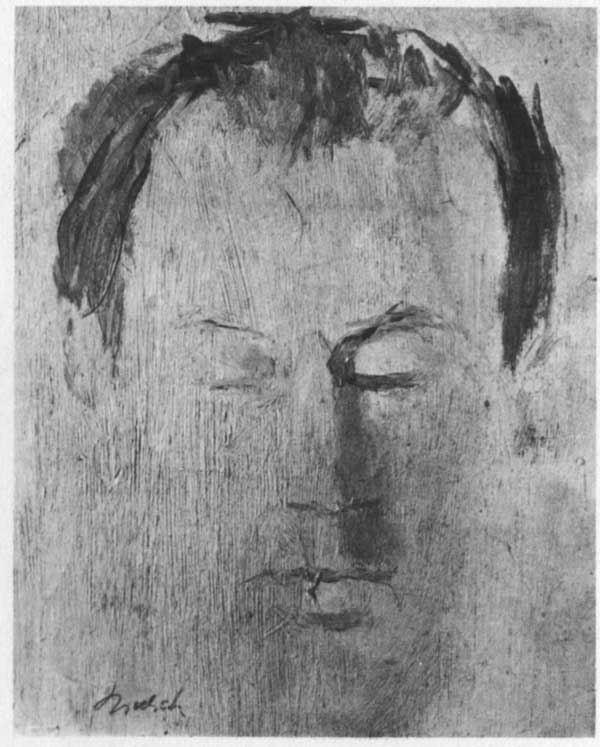
Portrait of Joesph Cornell 1940-1941 Oil on board, 10 x 8 inches
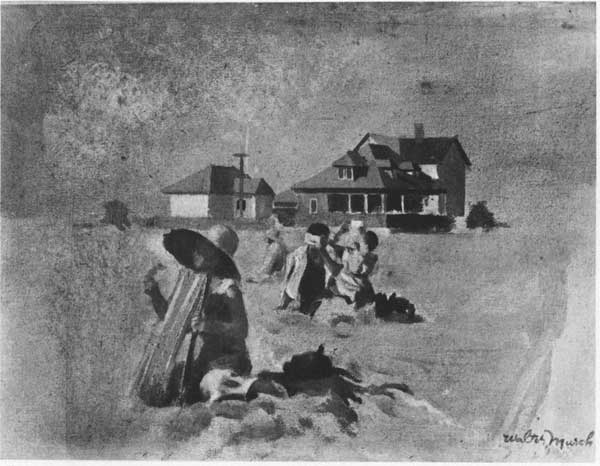
Eclipse, 1944 oil on canvas 12 x 16 inches
Please Click for a Larger View (true with most all of the images)
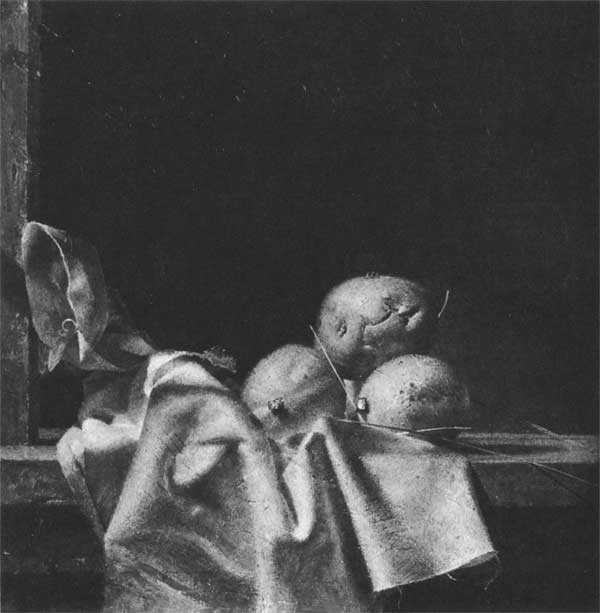
Lemons and Potato, 1945 15 x 15 inches oil on canvas
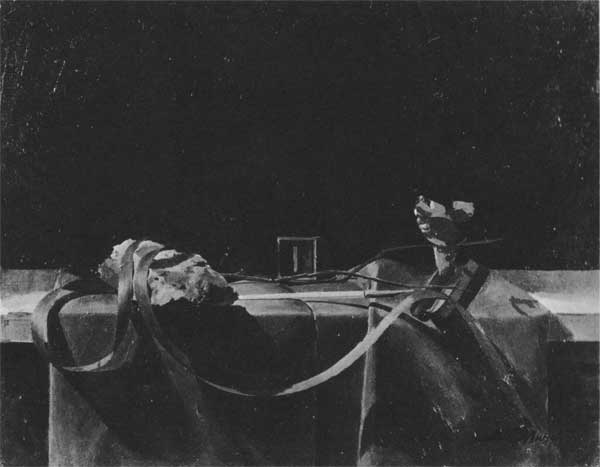
Still life with Red Ribbon, 1945 14 3/4 x 19 inches
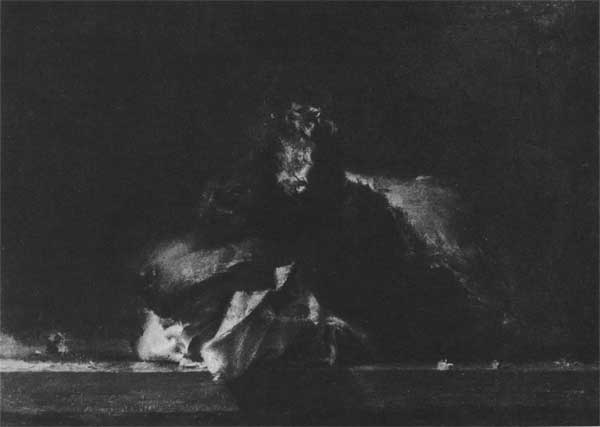
Dog’s Head, 1947 oil on canvas 13 1/2 x 18 1/2 inches
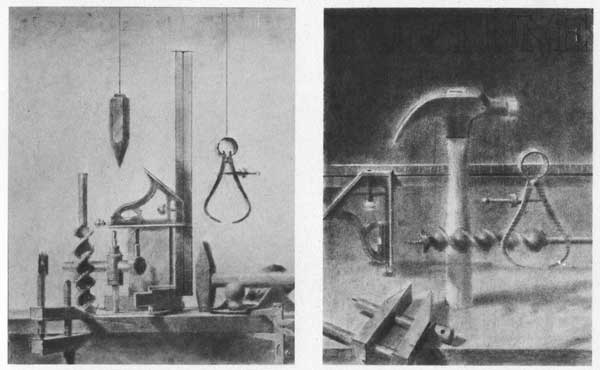
Two Projects for Fortune Magazine 1948
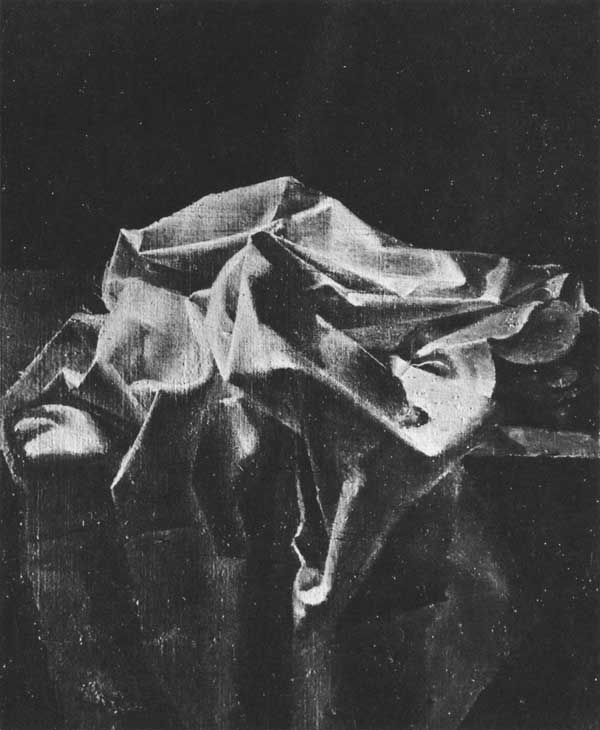
The Last Supper, 1947 oil on board 20 x 16 inches
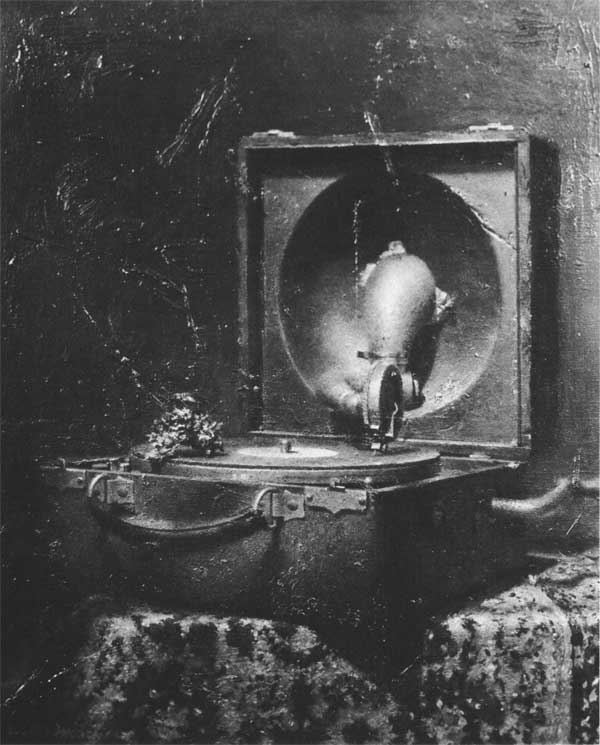
The Circle, 1948 oil on canvas, 26 x 21 inches

Cooked Eel, 1953 Oil on canvas 12 3/8 x 39 7/8 inches
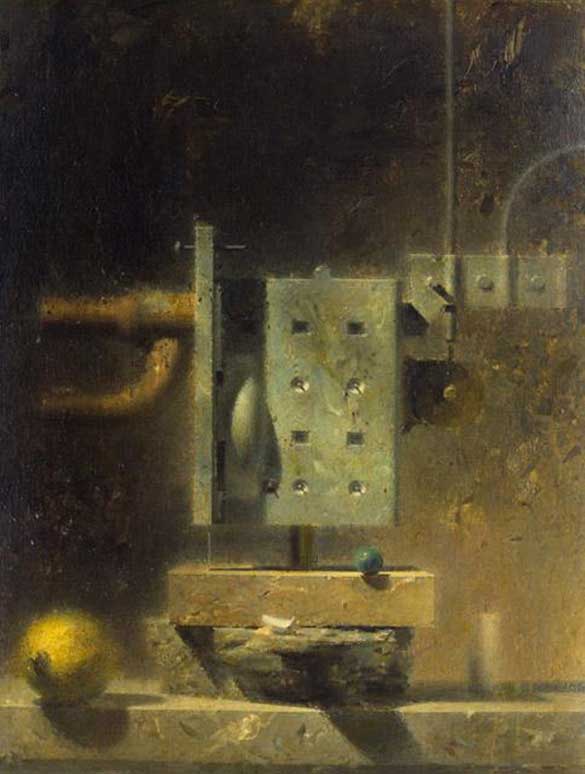
(color version) Car Heater, 1957 (no larger color image available)
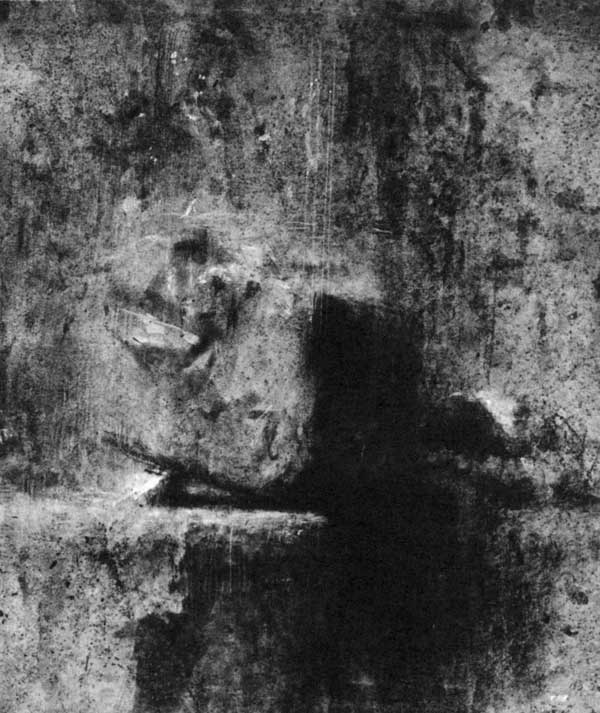
Drawing of a Rock on a Rug, 1961 Mixed Media on Wallpaper 17 x 14 inches
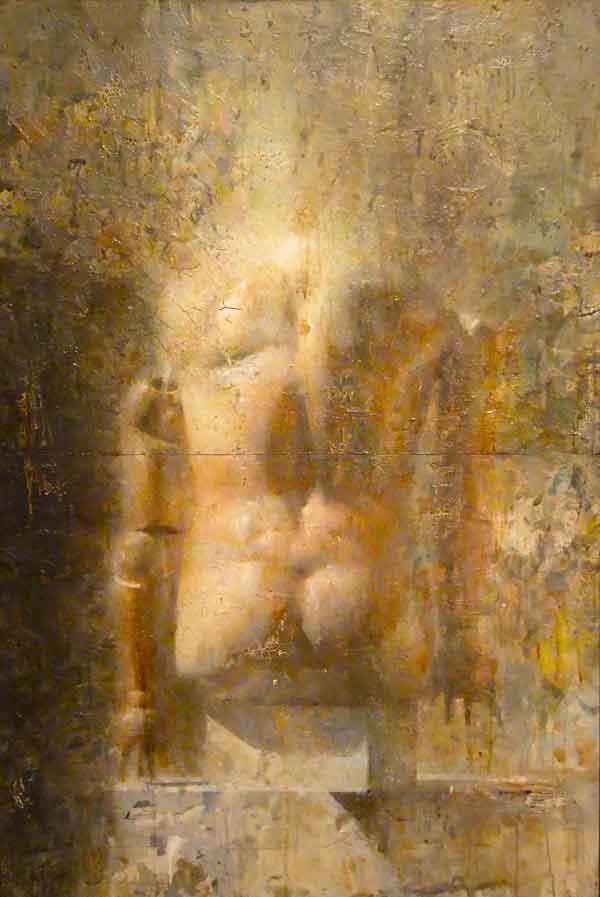
Color – Enlarged Doll, 1965
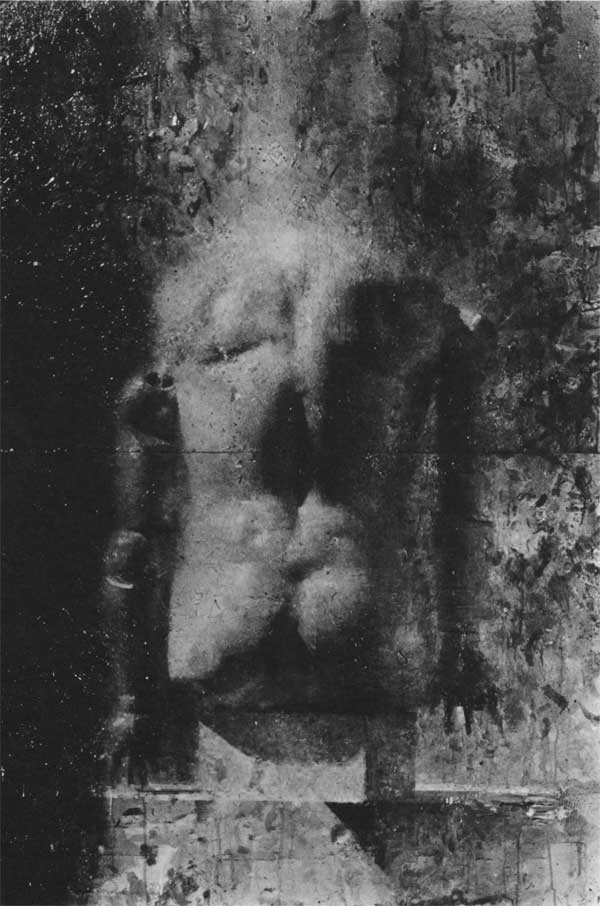
Enlarged Doll, 1965 48 x 32 inches
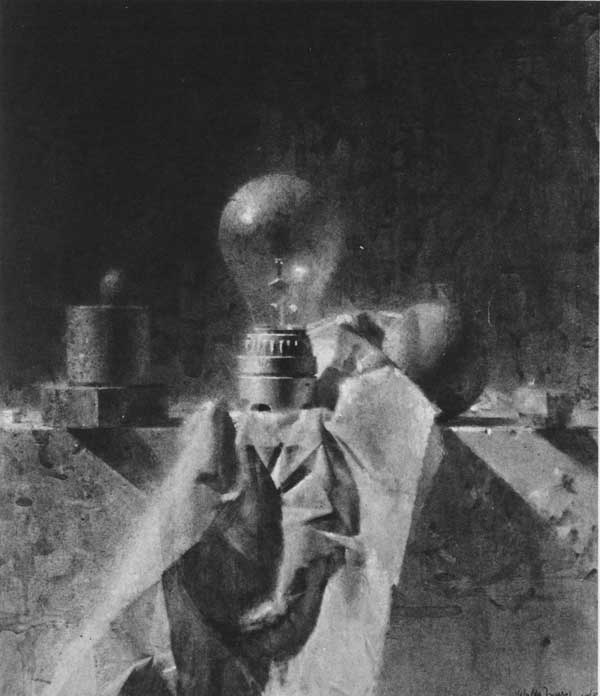
Glass of Water, 1965, Mixed media on paper 26 x 32 inches
Link to the PDF of the Essay by Daniel Robbins for the Walter Murch Retrospective

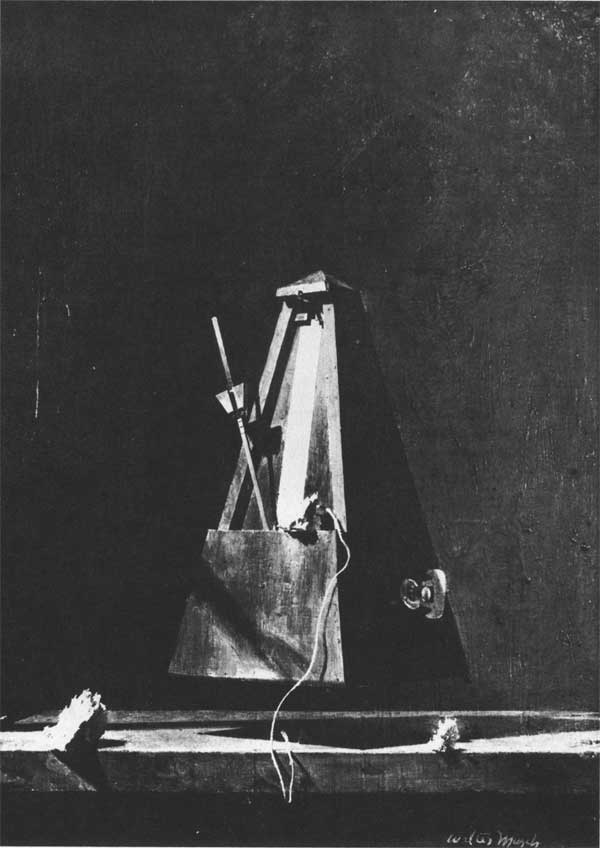
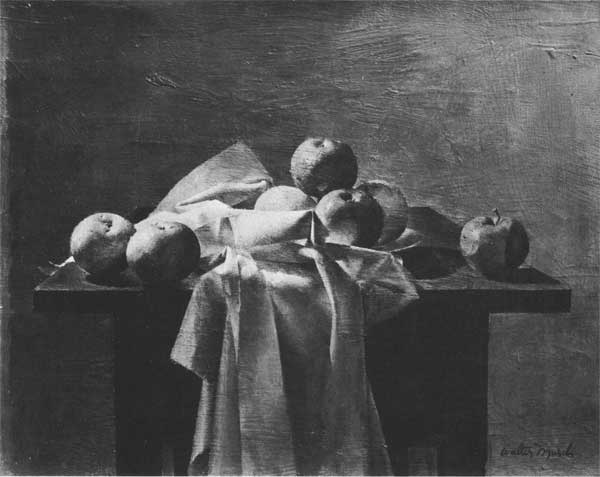
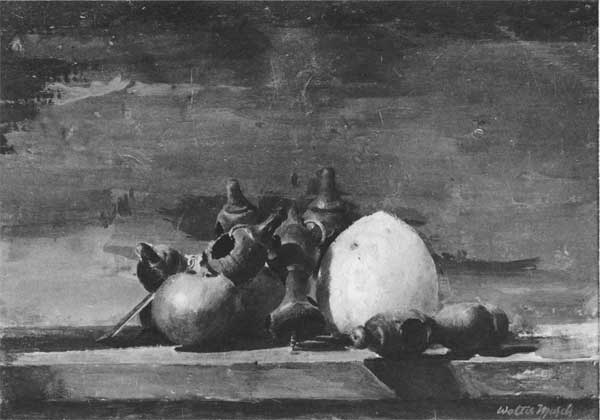
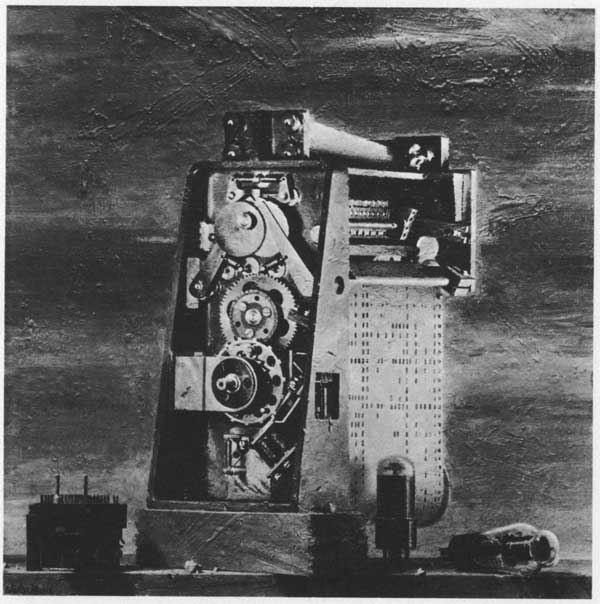

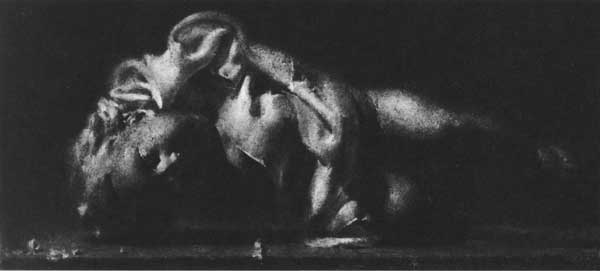
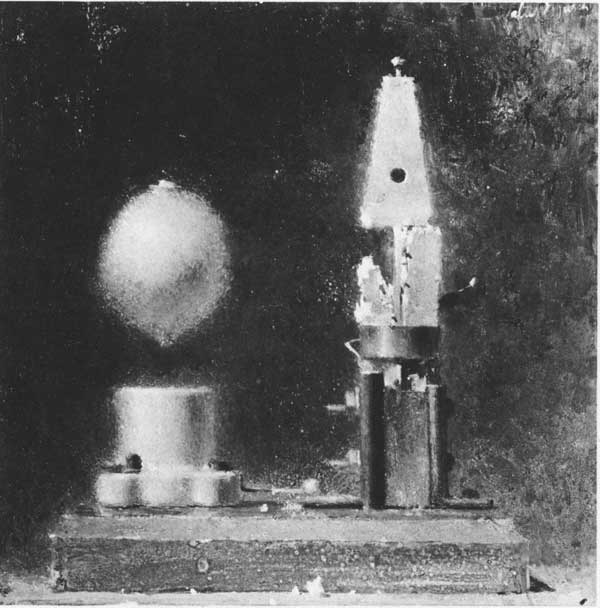
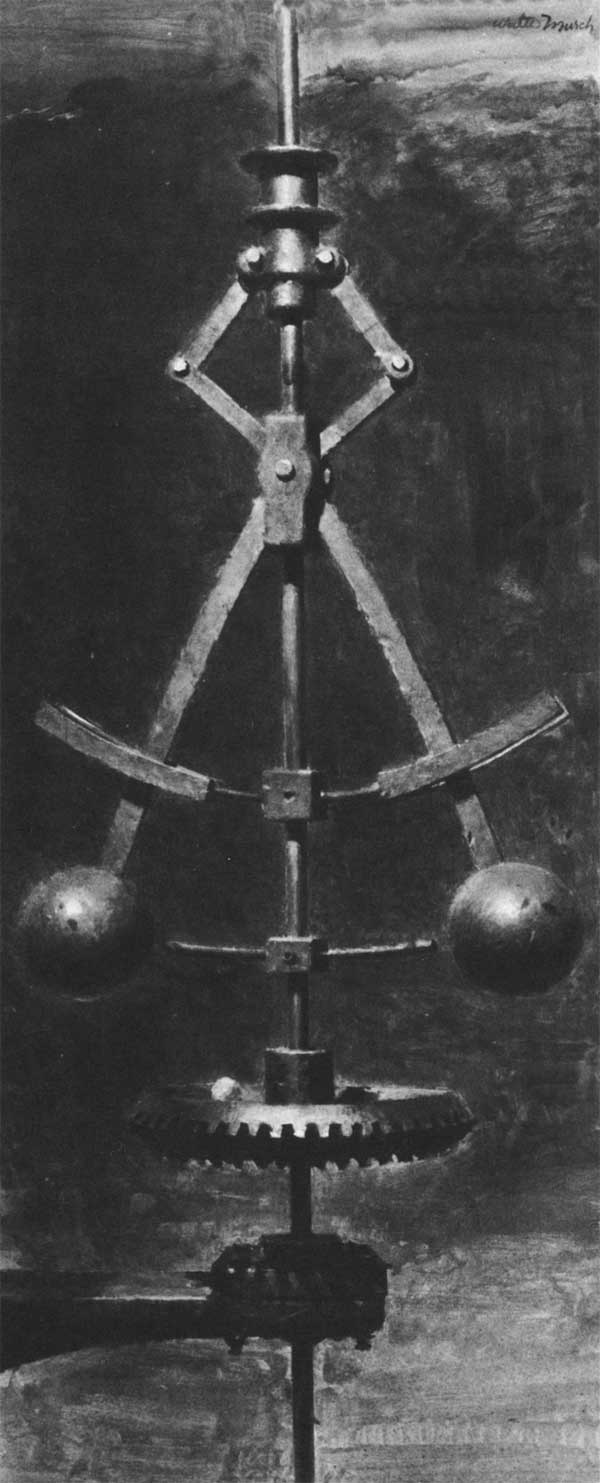
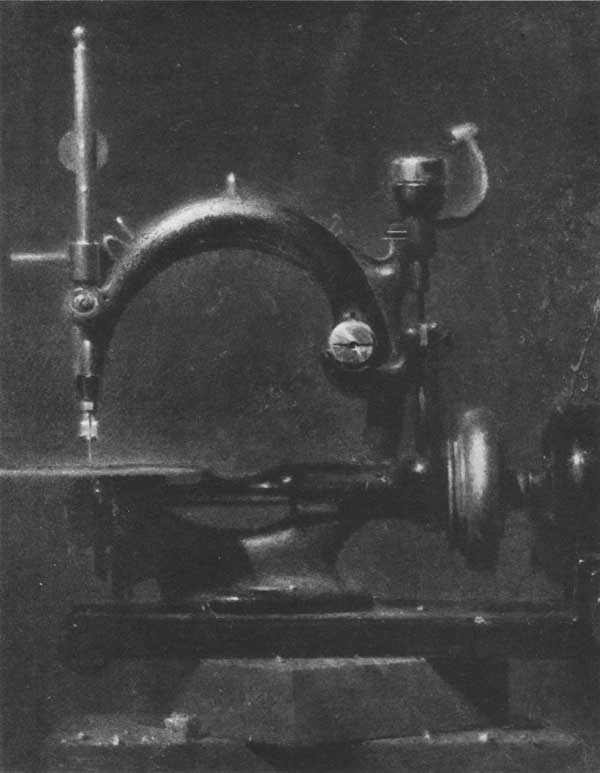
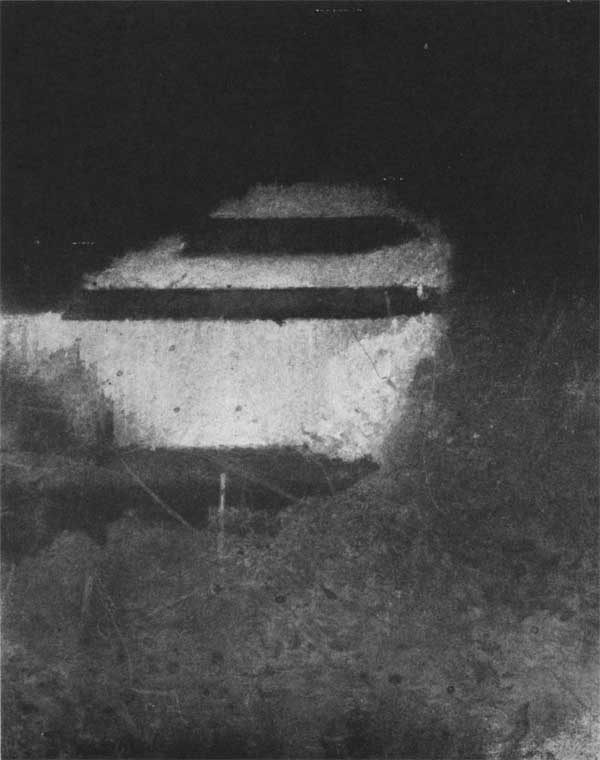
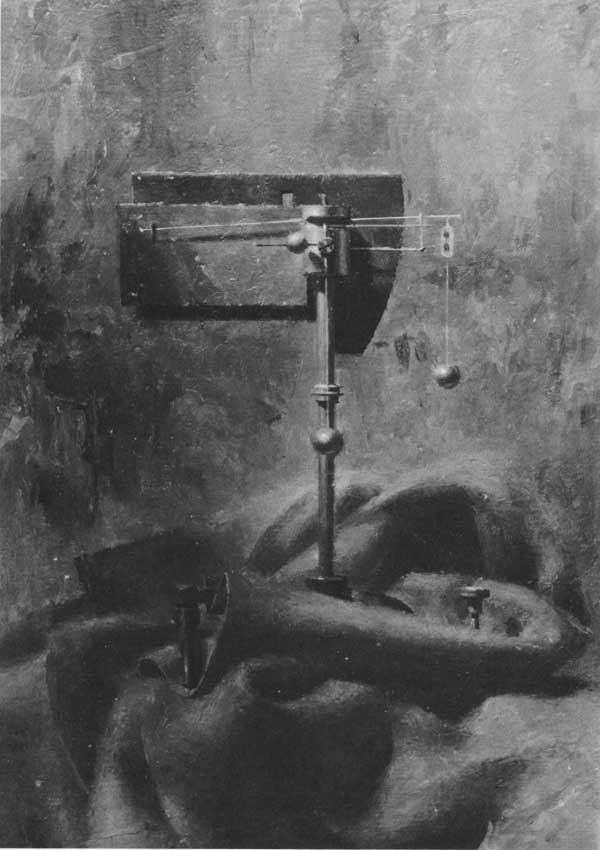
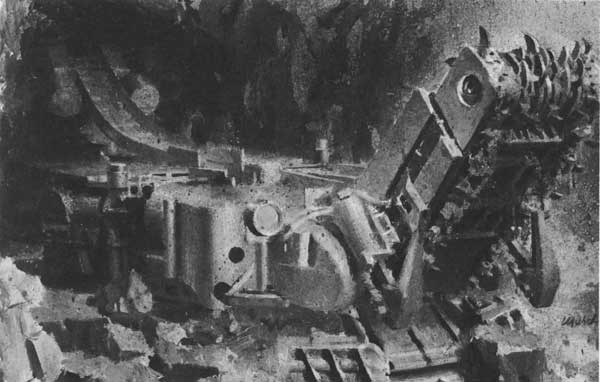
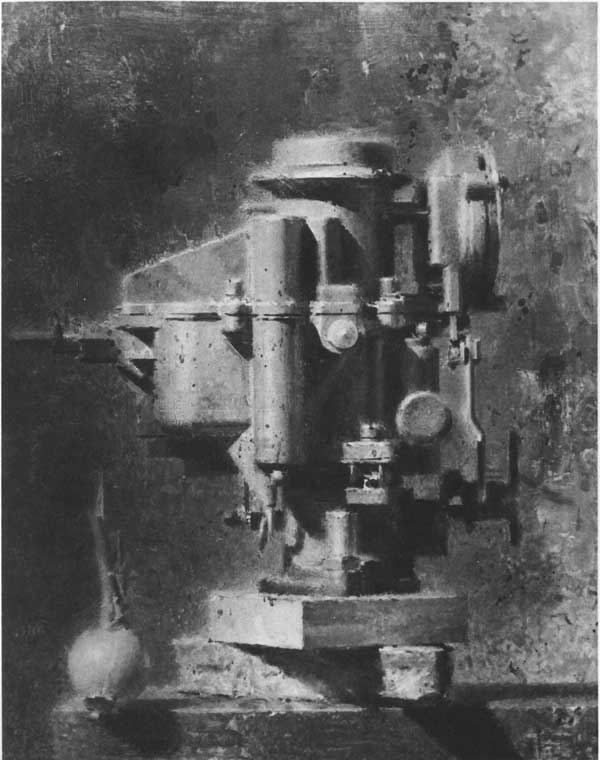
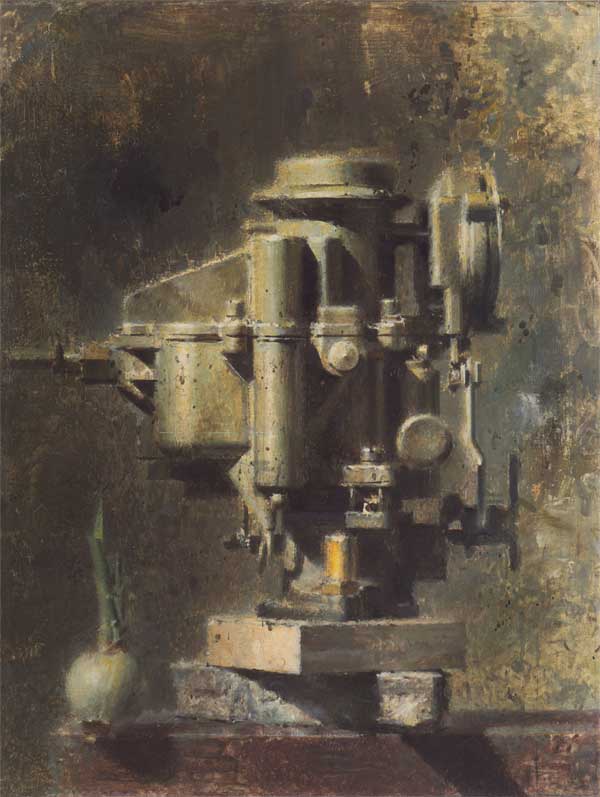
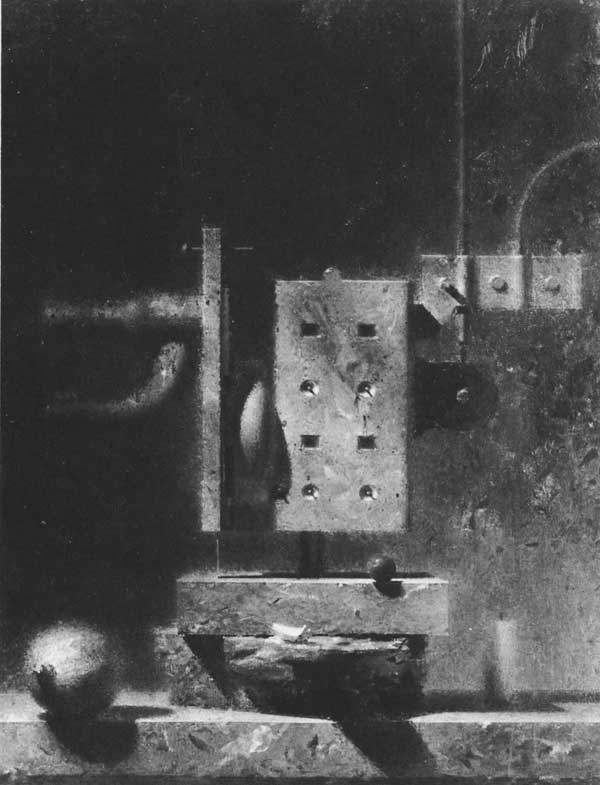
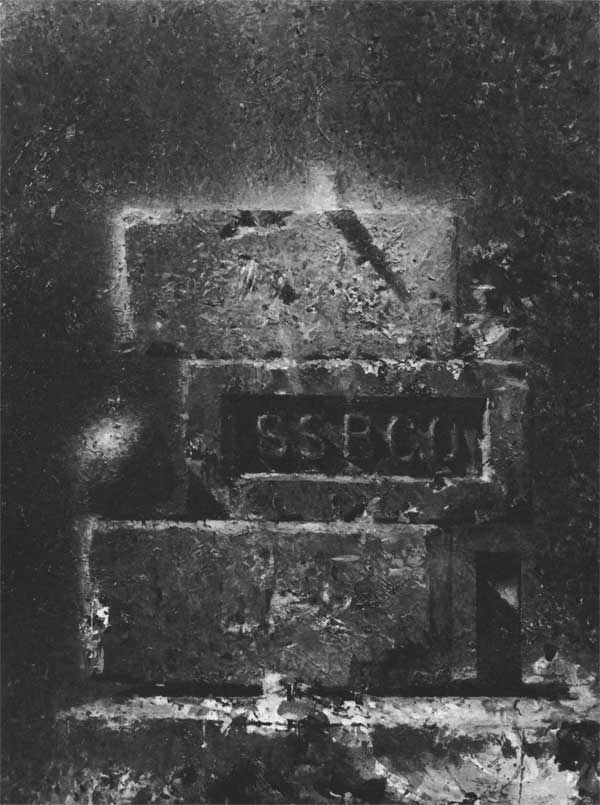
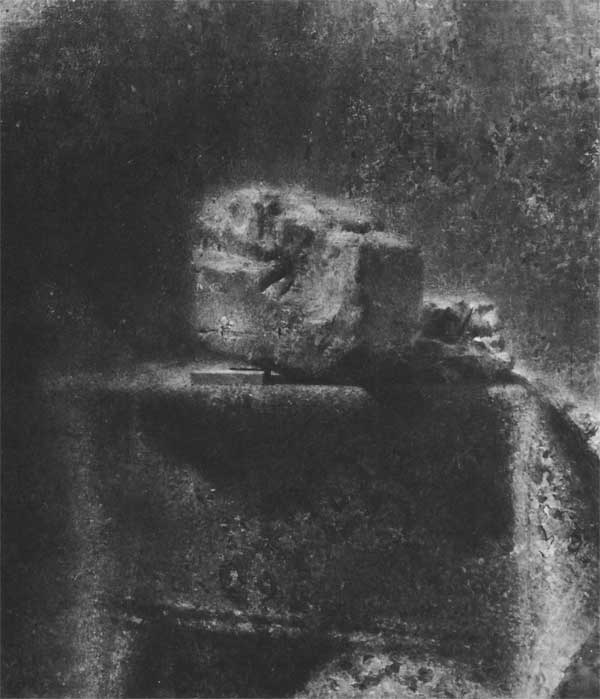
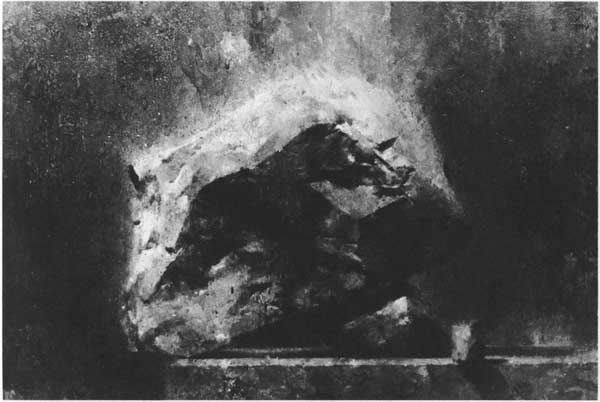
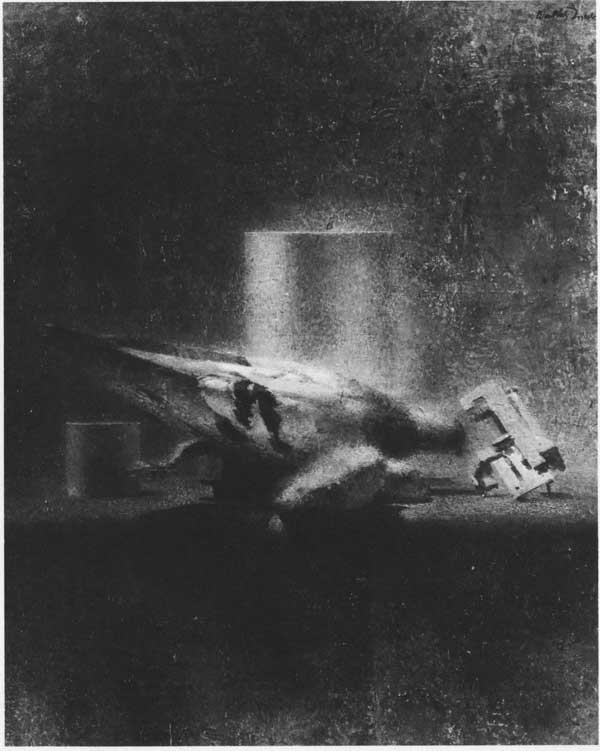
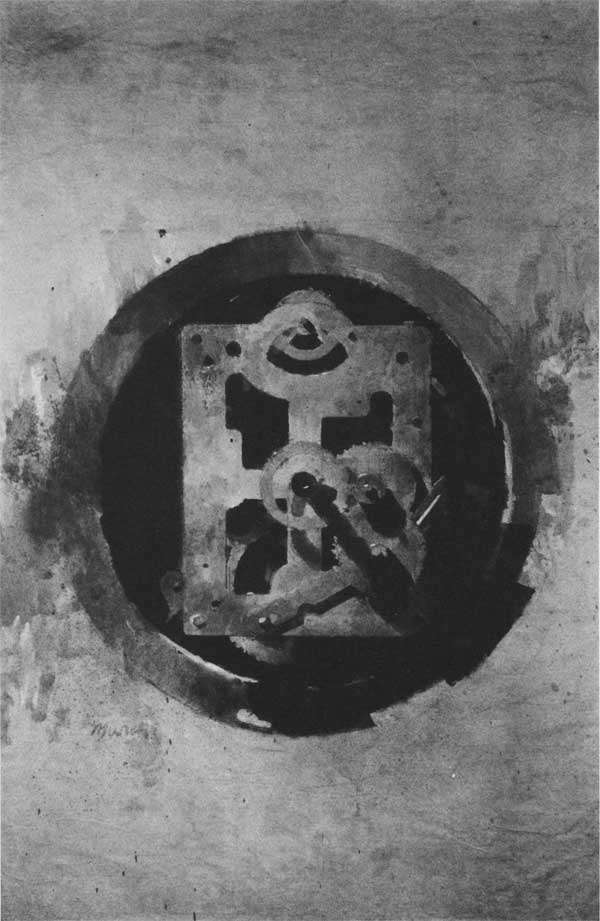
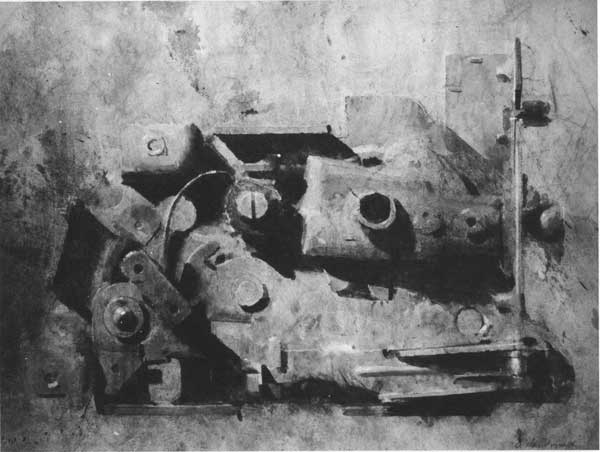
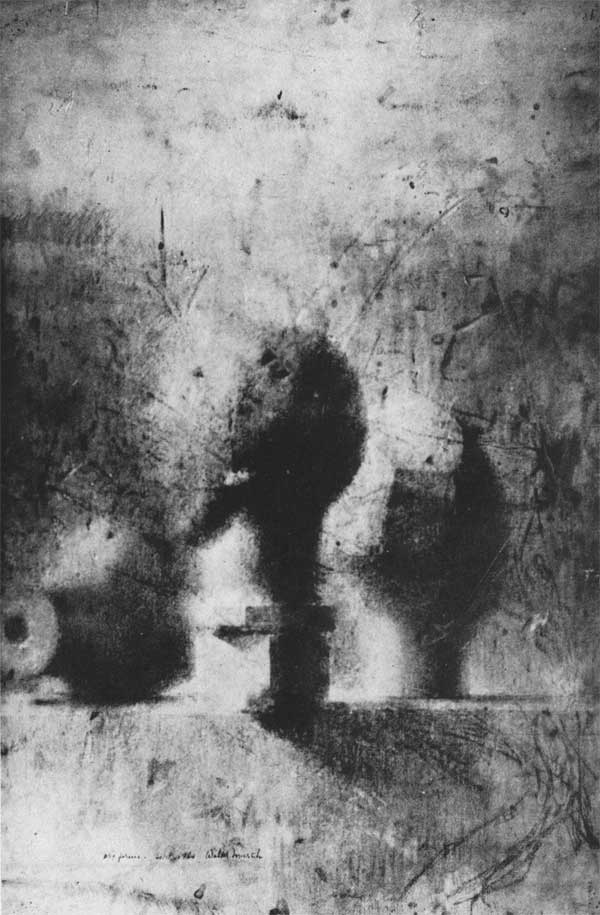
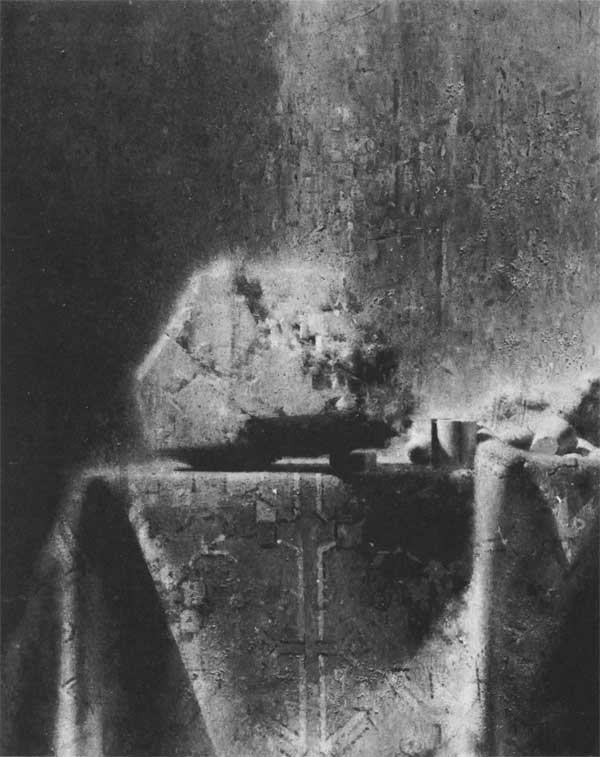
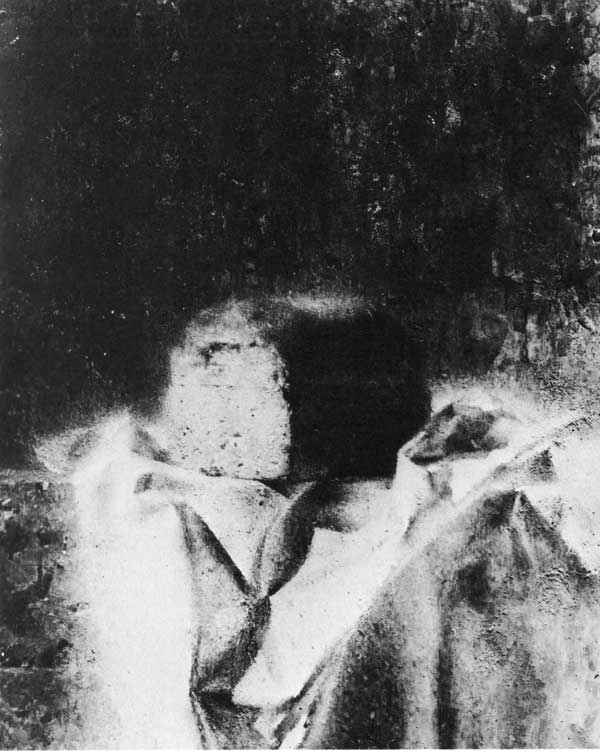
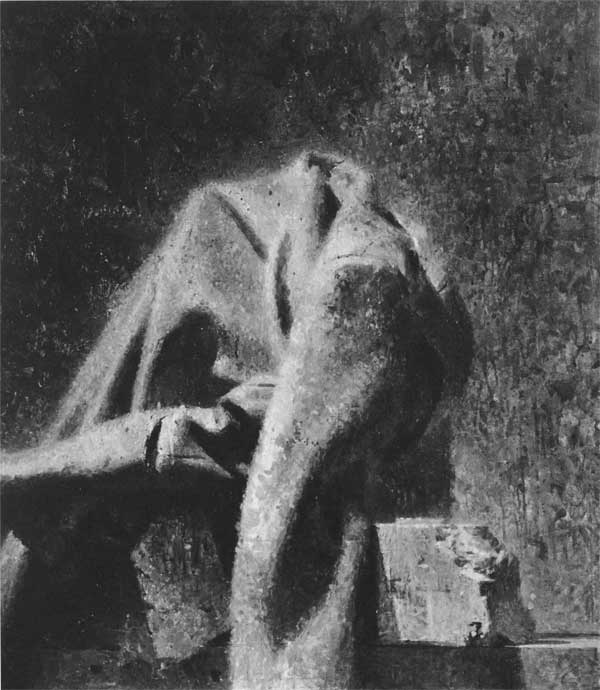




Larry – wow and thank you for posting these! These are extraordinary works, very riveting and soulful I think, and I have to say that I don’t feel like I am necessarily “missing out” on anything by their appearance here in black and white, for they look stunning like this! The power of the abstraction on the chiaroscuro level is so crucial to a painting, and so this only emphasizes Murch’s gift for perceiving the whole context. I marvel much at the sensitivity to texture and light. They feel too that they are certainly paintings of another time but ones which can still resonate deeply with painters and people today, which might explain my feeling of whiplash in looking at them, some kind of time travel warp, a connection with a painter of the past – and so thank you very much for making this wander into such beautiful paintings possible Larry!
Thanks for such a generous comment Rebecca. I’ve long wanted to share these images but I had lost the catalog when I moved from Boston to San Diego for a few years, I recently found it along with the time to scan the images and text. I feel Murch’s paintings are too important to be hidden away in only a few obscure catalogs on dusty library shelves, or basement storage rooms. Painters need to learn and be inspired from his work and I agree with what Phil Martin wrote in his comment about their power to enchant and animate wonder.
Thanks for your comments Bill, Kathryn and Francis.
I once saw a show that the Whitney musuem put together of his work along with a few of his actual still-life items as I recall (pretty sure) it was in the late 80’s I think in a satellite gallery in a Manhattan bank building. A fantastic show that included many of his major paintings (although not as comprehensive as the RISD show) had a deep impression on me.
I’ve just noticed this site; so glad to be able to view his work easily here. I agree with what Rebecca, Frances and Phil have said. Shall look for the book Bill mentions.
What acute sensitivity to light, texture and surface.
Thank you!
Larry, you’re wonderful.
Whoa… I remember as an undergraduate at Syracuse, one of my professors, told me that I should check out Walter Murch. At the time, I was basically trying to do Giacometti, still-life knock-offs (without the skill, stamina or maturity) in a muted palette of murky greys. I specifically remember the teacher talking about his surfaces and ‘accidental’ markings on the canvas, but when I went to look for images of his work at the library, I came up with a few, really poor reproductions. It’s all coming together now after about 20 years…Thanks so much for posting these. The precision of his forms is what strikes me now…the paintings do have a timeless quality similar to Morandi. Thanks Larry, you’re awesome!
I have long regarded Murch as the American counterpart to Morandi. Both used the still-life motif to explore formal concerns of tone, gesture, and fracture, and the expressive qualities of their respective media. In the process, the motif was transformed into something far more serious than objects on a tabletop. (Giacometti drawings have this quality too).
thank you for posting these wonderful images. They reanimate my sense of wonder, and enchant me.
I was also introduced to Walter Murch’s work by a painting teacher in college and have often searched the web for images. Thanks posting this. I’ve always admired his work.
Murch material is indeed in short supply, but fans of his work should know that there is a relatively new book on him – of which I am one of the authors – “Walter Tandy Murch: The Spirit of Things”. It is the book of the Murch exhibition that toured to four Canadian venues in 2009 & 2010. The book was published by the Robert McLaughlin Gallery in Oshawa, Ontario and is available either singly or in bulk from ABC Art Books in Montreal: http://www.abcartbookscanada.com/
The book is 96 pages, with lots of colour.
My text in the book does reference Morandi, as a pre-echo to the comment by Phil Martin posted here, but also draws some comparisons between Murch and Walter Benjamin, which need further elaboration at some point.
Thanks for your comment Mr. Jeffries. I had ordered your book from Amazon when I first heard of your book and show of Murch’s work (regretfully, I always seem to find out about these events long after they’re over) I just received it yesterday and it looks fabulous. I look forward to reading the text. Hopefully my post here will help spread your book popularity as well as Walter Murch in general. By the way I did link to your book at Amazon in my post but I wonder if there may already be short supply as it is no longer available at Barnes and Noble (just expensive used copies there) So I would recommend anyone to get your copy now to avoid the outrageous mark-ups by used book dealers. (I no longer get affiliate sales from Amazon due to CA tax law changes – so I’m bummed Barnes and Noble no longer carries the book!) I will change the link to point to your recommended ABC Art book site instead of Amazon. Thanks again for this information.
Thank you for showing these. I did not know of Murch’s work. They seem so contemporary to today. I would love to see the actual paintings and get a feel for their surface. Wonderful work.
Larry, once again thank you. This blog has become one of my favorite online destinations. Your presentations whet the appetite and get the marbles in my head to rolling around.
Mr. Jeffries, I just ordered one of your books from Amazon (only two left after me), and am looking forward to reading your essay. I am very interested in your comment above relating Murch with Benjamin. Would it at all be possible for you to elaborate on this connection here on Larry’s blog, maybe in the forum section? It would add so much value to this now very popular blog. Larry has posted about politics and art in the past, and a forum thread started by you about Murch and Benjamin would be awesome!
Thanks Larry again for your fantastic work, and Mr. Jeffries for your work and consideration of my above request.
Sincerely,
Noel
Larry,thanks so much!! Murch is one of my favourite painters but have never managed to get much info on him(until now!)thanks also for the heads up about the book!great blog, keep up the good work!many thanks robert.
We at ABC Art Books Canada Distribution want you all to know that the publication “Walter Tandy Murch: The Spirit of Things” is still available, new, and at its original price from ABC or from Amazon.com. We see that Amazon has just sold through and we are shipping another order this week.
Buyer Beware: my review at Amazon for “Walter Tandy Murch: The Spirit of Things”
After years of wishing for some extended pictorial source for this important artist, I was pleased to hear of this catalog. Unfortunately the production of the book was handed over to a design team who were more concerned with style than substance. Beginning with a wholly pointless multi-fold dust jacket that folds out to a poorly done montage of the paintings, the entire project betrays a disdain for the artist and his work. Lots of multi-lingual text gets set too small, too tight, and too long for comfortable reading. But it’s the paintings we want to see, right? I immediately discarded the jacket, because the paperbound book was uncomfortable to page through, which helped some, but the binding was some kind of perfect glue which involved a quarter-inch spine, so at least a visual half inch was absorbed by the gutter, so what to do as a responsible designer? Why, do as these professionals did: lay out everything tight to the center, so that type and paintings alike were sucked into the center. Bad enough, but some paintings were arbitrarily split–even on pages where there was plenty of room to present the entire reproduction in clear space. Well, it probably looked good flattened on the screen, but that’s a baby mistake for a professional. Disdain for the artist, disdain for the consumer. I can’t recommend it.
What a find you are! Your piece on Walter Murch has catapulted me back 45 years when I was a student at RISD working on the side as a curatorial assistant to Danny Robbins. (I am looking at my copy the Murch catalogue as I type.) Back then,
my name was Anne Boardman. I was intimately involved in the proof reading and editing of the catalogue. Danny (and the designer, Malcolm Grear) were extraordinarily devoted to presenting the true spirit and magic of Murch. As a result I have had a life long passion and respect for Walter’s paintings.
You made a masterful job of scanning the catalogue, interspersing Murch’s works with Danny’s text.
I remember we were all miffed at the Rose Art Museum for not lending their Murch. They are still goofing up, aren’t they!
I miss Danny very much. He was godfather to my first son.
P.S. That same year we discovered a crawl space in back of the “dead storage” room in the basement of the museum with thrown aside 19th century landscapes. We named it the “dead dead storage.” William Merritt Chase, Martin Johnson Heade and Edward Mitchell Bannister were among them! Danny had them resurrected and restored. They are now the pride of the collection.
Thank you for your comment Anne and for your helping to bring that Walter Murch catalog into being. It is a crime that so many great paintings are banished into dead storage by changing tastes of museums.
We are from florence “Accademia delle Arti del Disegno”, we are looking for Anne Boardman for the 50th anniversary of the great flood and CRIA. Please write us at info@aadfi.it
Thank you for posting, I landed on this ‘following’ Murch from a note I found on Margaret Davindson’s ‘contemporary drawings’I am an italian architect living in Scotland and studying a BA hons in Painting at the Open College of Art..
posts like yours make me going back to study remarkably pleasurable.
thanks again
Lucia Volpi Dunn
I have just discovered this wonderful site. I have had a reproduction of Murch’s sewing machine
on my studio wall since I saw his work at Parsons in the mid-1950s. He is the Industrial Morandi.
And, maybe, the Working Man’s Chardin. Soulful is so right. Scientific American had his work on the
cover quite often in the 50s. Ben Shahn’s wife was the art director then, I think.
Walter Murch has long been one of my favorite painters and was instrumental my wanting to learn how to paint representationally. You are lucky to have a poster of the sewing machine painting – love it! Thanks for your comment.
The “Self-portrait with Glasses, c. 1960” at the top of this online article was dated looks as if it were painted at least 10 years before 1960. I was lucky enough to take a drawing class at Boston University with Walter Murch around 1966. He was the most profound studio teacher I ever had (in 8 years of college and graduate study, and the quote at the top of this article captures the essence of his mysterious guidance. He had us lay our large half-finished nude figure drawings out on Commonwealth Avenue in Brookline, in front of the B. U. art studio – long enough for muddy footsteps and tire tracks lay their gray-brown imprints. Then we were to rework our drawings, even upside down, integrating the random textures and marks with those we made while observing the model. The point was that we were learning to make drawings, not illustrations of the figure.
I will add the Conger Metcalf also taught drawing at B. U. at that time and was another wonderful teacher of observation and sensitive weighted line (to convey shadow, gravity, negative space, focus) and learning to see the overlapping of muscles and bones below the skin by the slightest nuances of the contour line and its quality of softness, angularity, and overlapping lines or shadows. Add painter Arthur Polonsky to this mix, and there was a humanist, enigmatic and oblique, but very encouraging and helpful in a spiritual, almost non-verbal way, though he was amiable and conversant.
Thank you for your wonderful article!
I had the great good fortune to work with Walter Murch for a few months before he died. He would walk around and look at your work and often not say anything but he was thinking about it. Then when the time was right he would softly say something that would completely open up the way you’d been thinking about it. He didn’t talk just to make noise as many teachers do. He wasn’t afraid of silence but when he spoke it changed everything. The “Old Guard” faculty at B U were real artists who brought the insights of a lifetime of work and experiment in their studios into the classrom. I also worked closely with Conger Metcalf who was a wonderful artist and a profoundly good man. David Aronson, Joseph Ablow, Reed Kay, John Wilson, Richard Yarde, David Ratner, Lou Cohen, LLoyd Lillie,
Arthur Polonsky and others created an environment that felt more like an apprenticeship than a college art dept. They were, and are amazingly dedicated artists and there was a seamlessness between what they did as artists and how they taught. I didn’t realize at the time how unusual a thing that would become. I didn’t know then that I would spend the next 40+ years as an artist who also worked as a college level art teacher. Their example has guided me to the best of my abilities.
Bonjour,
Hello,
Heureux d’avoir découvert aujourd’hui, grâce à vous, ce peintre dont j’ignorais l’existence et surtout l’œuvre. Il peint le temps; il peint la fragilité de toute image. Ce faisant, il nous peint.
Encore merci.
For a moment there, I thought I was looking at the face of ‘The Milk Maid’ by Vermeer. I recall reading somewhere a quote by Walter Murch where he described his technique. He would give the under painting a least two layers of paint then scrape it back after it was dry “with any thing at hand”….. probably a fine sand paper, scalpel or both. Anything to DISTRESS the surface! He would then build the image with touches of paint on what was left behind. What your looking at is a result of building and erasure, with his sensibility between the layers. When you stop is up to you.
I am trying to find out more about the Murch painting of a musical instrument that became the November 1962 Cover of Scientific American. Research for an upcoming biography of violin maker Carleen Hutchins. Please advise. Quincy Whitney?
I have purchased a landscape painting on canvas from a sale in Kansas City it is signed TMurch 62 but does not look like these examples, however I am puzzled because looked at the mark on the back of the canvas and the maker is from Brooklyn New York. Do you know of other example of his work that are landscapes and do you know if he ever signed TMurch? Thanks for you help.
I had Walter as my painting instructor my senior year at Boston University, 1963, and spent my masters program with him until 1965. His voice and comments remain with me. He urged me to throw dirt on the gessso canvas. Finally in frustration I did and produced some of my more energized pieces. His reply when asked why, he said, ” I wanted you to get beyond seducing yourself with your ability to draw.” He always looked into where the student was trying to go, not just pushing his style. He was an incredible person.
I was,a student if Walter Tandy Much in the mid 60’s at Boston University and at the Skowhegan School in Maine. I can attest to the powerful.magic of his work as well as the greatness of his,yeaching. He opened many doors in my mind during those years. Great man!